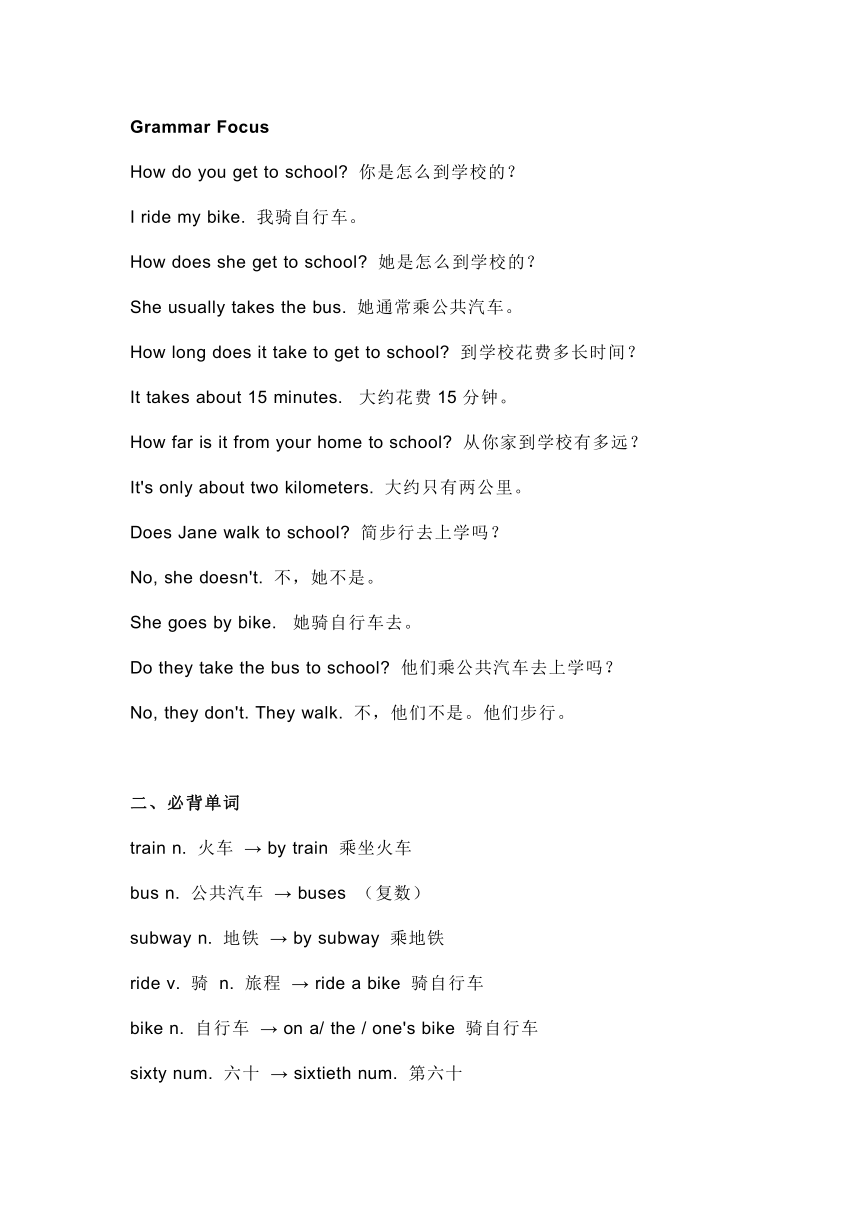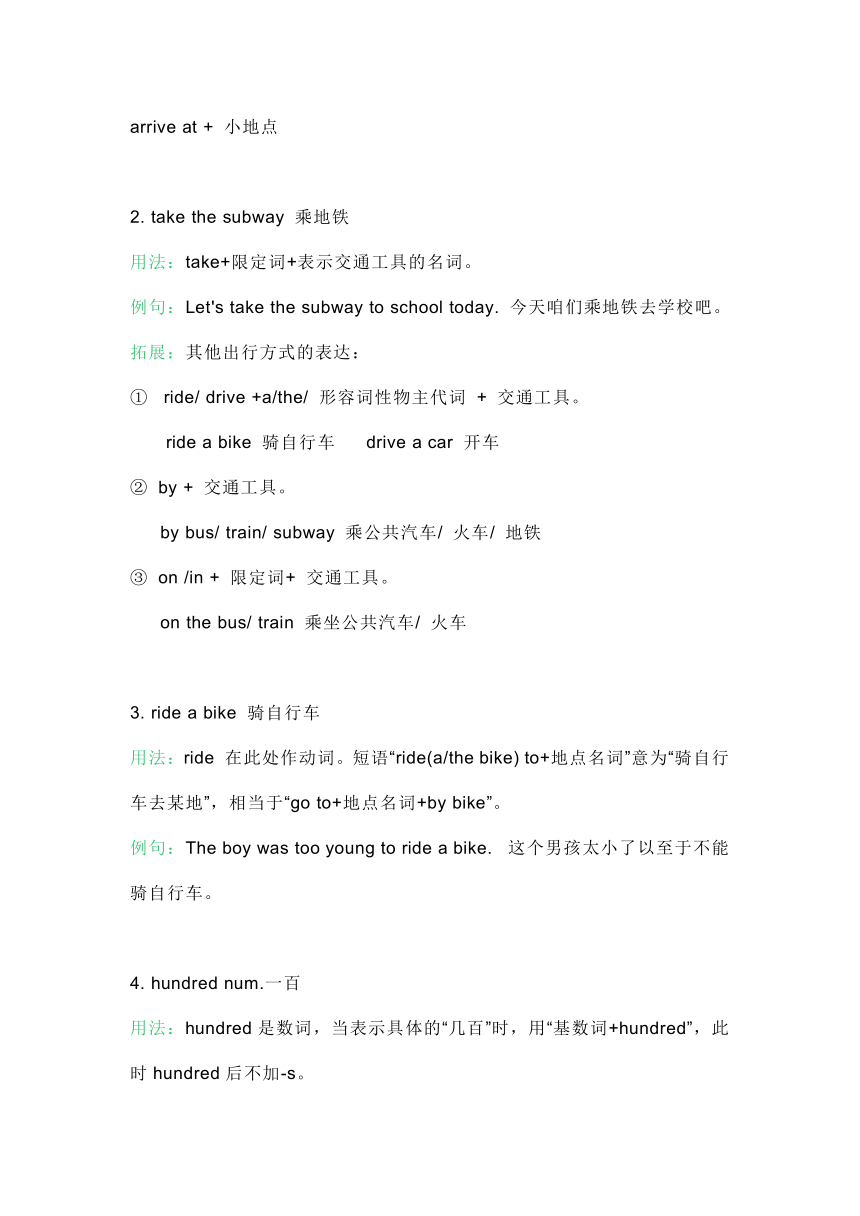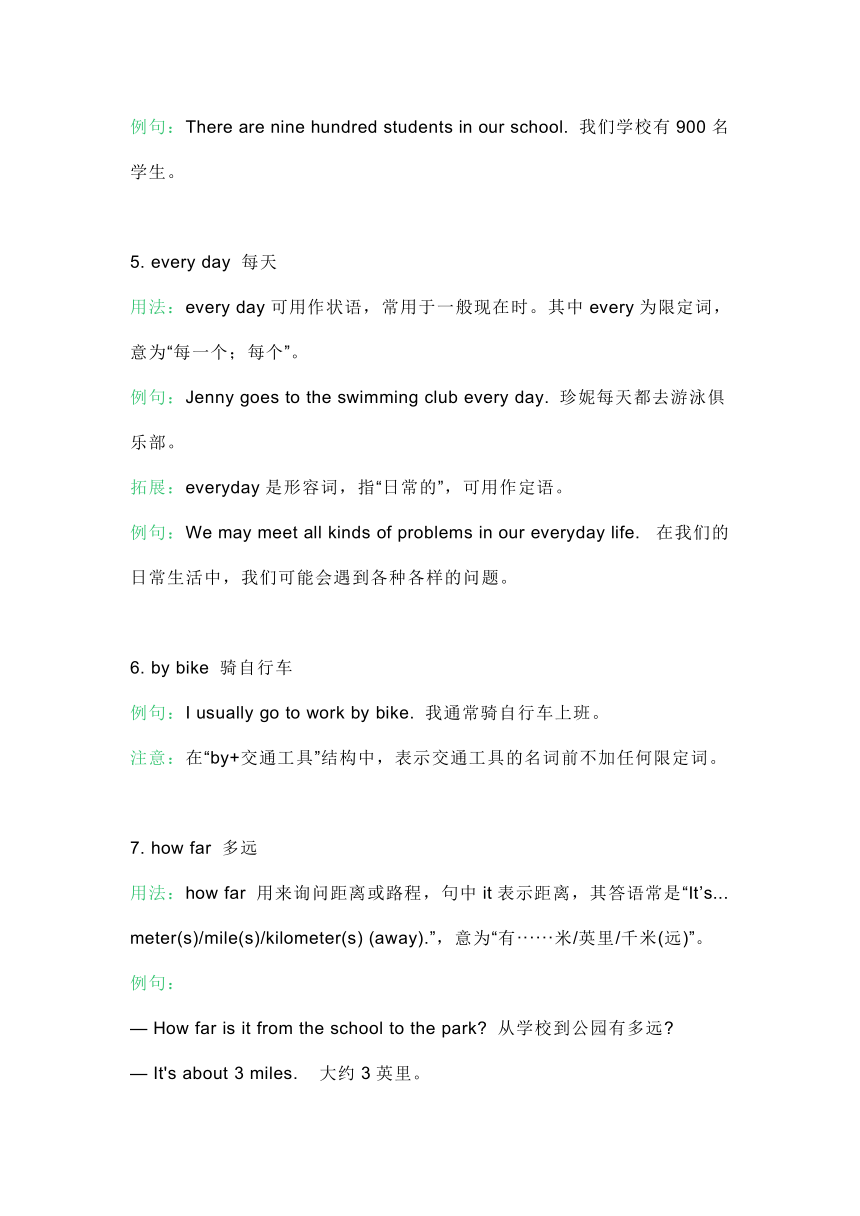人教版七年级下册Unit 3 How do you get to school? 单元预习资料
文档属性
| 名称 | 人教版七年级下册Unit 3 How do you get to school? 单元预习资料 |

|
|
| 格式 | docx | ||
| 文件大小 | 26.8KB | ||
| 资源类型 | 教案 | ||
| 版本资源 | 人教新目标(Go for it)版 | ||
| 科目 | 英语 | ||
| 更新时间 | 2024-04-20 10:00:48 | ||
图片预览





文档简介
七年级下册英语人教(PEP)版第3单元预习资料
Unit 3 PartA
一、课文翻译
教材第14页2e课文翻译
2e Role-play the conversation.
Lisa: Hey, Jane. Is this your new bike 嘿,简。这是你的新自行车吗?
Jane: Yes. I ride it to school every day. How do you get to school 是的。我每天都骑着它去上学。你怎么去学校?
Lisa: I usually take the bus. 我经常坐公交车。
Jane: How far is it from your home to school 从你家到学校有多远?
Lisa: I'm not sure... about 10 kilometers The bus ride takes about 20 minutes. How long does it take you to get to school 我不太确定······ 大约10公里 坐公交车大概需要花20分钟。你需要多久到学校?
Jane: About 15 minutes by bike. It's good exercise. 骑自行车大概需要15分钟。这是很好的锻炼方式。
Lisa: Yeah. Well, have a good day at school. 是的。好了,今天在学校过得开心。
Jane: You, too. 你也是。
教材第15页Grammar Focus课文翻译
Grammar Focus
How do you get to school 你是怎么到学校的?
I ride my bike. 我骑自行车。
How does she get to school 她是怎么到学校的?
She usually takes the bus. 她通常乘公共汽车。
How long does it take to get to school 到学校花费多长时间?
It takes about 15 minutes. 大约花费15分钟。
How far is it from your home to school 从你家到学校有多远?
It's only about two kilometers. 大约只有两公里。
Does Jane walk to school 简步行去上学吗?
No, she doesn't. 不,她不是。
She goes by bike. 她骑自行车去。
Do they take the bus to school 他们乘公共汽车去上学吗?
No, they don't. They walk. 不,他们不是。他们步行。
二、必背单词
train n. 火车 → by train 乘坐火车
bus n. 公共汽车 → buses (复数)
subway n. 地铁 → by subway 乘地铁
ride v. 骑 n. 旅程 → ride a bike 骑自行车
bike n. 自行车 → on a/ the / one's bike 骑自行车
sixty num. 六十 → sixtieth num. 第六十
seventy num. 七十 → seventieth num. 第七十
eighty num. 八十 → eightieth num. 第八十
ninety num. 九十 → ninetieth num. 第九十
hundred num. 一百 → nine hundred 九百
minute n. 分钟 → minutes (复数)
far adv. & adj. 远;远的 → be far from 离 ······ 远
kilometer n. 千米;公里
new adj. 新的;刚出现的 → old(反义词)旧的
every adj. 每一;每个
by prep.(表示方式)乘(交通工具)→ by bus 乘公共汽车
drive v. 开车 → drive one's car 开某人的车
car n. 小汽车;轿车 → by car (in a/the car) 乘小汽车
live v. 居住;生活 → live in/on ... 居住/生活在 ······
三、必会考点
1. get to 到达
用法:“get to+地点名词”意为“到达某地;抵达某地”,当后面接home,there,here等副词时,要省略介词to。
例句:How does Jim get to school 吉姆怎样到学校
拓展:“到达某地”的其他表达方法:
reach (及物动词)+地点
arrive in + 大地点
arrive at + 小地点
2. take the subway 乘地铁
用法:take+限定词+表示交通工具的名词。
例句:Let's take the subway to school today. 今天咱们乘地铁去学校吧。
拓展:其他出行方式的表达:
① ride/ drive +a/the/ 形容词性物主代词 + 交通工具。
ride a bike 骑自行车 drive a car 开车
② by + 交通工具。
by bus/ train/ subway 乘公共汽车/ 火车/ 地铁
③ on /in + 限定词+ 交通工具。
on the bus/ train 乘坐公共汽车/ 火车
3. ride a bike 骑自行车
用法:ride 在此处作动词。短语“ride(a/the bike) to+地点名词”意为“骑自行车去某地”,相当于“go to+地点名词+by bike”。
例句:The boy was too young to ride a bike. 这个男孩太小了以至于不能骑自行车。
4. hundred num.一百
用法:hundred是数词,当表示具体的“几百”时,用“基数词+hundred”,此时hundred后不加-s。
例句:There are nine hundred students in our school. 我们学校有900名学生。
5. every day 每天
用法:every day可用作状语,常用于一般现在时。其中every为限定词,意为“每一个;每个”。
例句:Jenny goes to the swimming club every day. 珍妮每天都去游泳俱乐部。
拓展:everyday是形容词,指“日常的”,可用作定语。
例句:We may meet all kinds of problems in our everyday life. 在我们的日常生活中,我们可能会遇到各种各样的问题。
6. by bike 骑自行车
例句:I usually go to work by bike. 我通常骑自行车上班。
注意:在“by+交通工具”结构中,表示交通工具的名词前不加任何限定词。
7. how far 多远
用法:how far 用来询问距离或路程,句中it表示距离,其答语常是“It’s... meter(s)/mile(s)/kilometer(s) (away).”,意为“有······米/英里/千米(远)”。
例句:
— How far is it from the school to the park 从学校到公园有多远
— It's about 3 miles. 大约3英里。
8. I'm not sure 我不确定
用法:该句式表达自己对某事没有足够的把握,后面还可以接宾语从句。
例句:I'm not sure if we've lost anything... 我不确定我们是否失去了什么······
9. it takes ( sb. ) some time to do sth. 花费(某人)多长时间做某事
用法:这里的“it"是形式主语,“to do"才是真正的主语。
例句:It takes me twenty minutes to walk to the zoo. 步行到动物园花费我20分钟。
Unit 3 PartB
一、课文翻译
教材第17页2b课文翻译
2b Read the news story from some years ago and choose the best title for it.
A. How to Get to school 怎么去上学
B. Crossing the River to school 过河去上学
C. Going to School Is Fun 上学很有趣
How do you get to school Do you walk or ride a bike Do you go by bus or by train For many students, it is easy to get to school. But for the students in one small village in China, it is difficult. There is a very big river between their school and the village. There is no bridge and the river runs too quickly for boats. So these students go on a ropeway to cross the river to school. 你是怎么到学校的?你步行还是骑自行车?你是乘公共汽车去还是乘火车?对许多学生来说,到达学校是容易的。但对于中国的一个小村庄的学生来说却很难。在他们的学校和村庄之间有一条很大的河。河上没有桥,而且河水湍急,不宜小船摆渡。因此这些学生乘索道过河去上学。
One 11-year-old boy, Liangliang, crosses the river every school day. But he is not afraid because he loves school. "l love to play with my classmates. And I love my teacher. He's like a father to me. " 亮亮,一个11岁的男孩,每天过河上学。但是他并不害怕,因为他爱学校。“我喜欢和我的同学们玩耍。我喜欢我的老师,对我来说他就像父亲一样。”
Many of the students and villagers never leave the village. It is their dream to have a bridge. Can their dream come true 许多学生和村民从未离开过村庄。有一座桥是他们的梦想。他们的梦想能实现吗
二、必背单词
stop n. 车站;停止 → at the stop 在车站
cross v. 横过;越过 → crosses (第三人称单数)→ crossing (现在分词)
river n. 河;江 → in the river 在河里
many adj. & pron. 许多 → more (比较级)→ most (最高级)
village n. 村庄;村镇 → villager 村民 → in a village 在村庄里
between prep. 介于······之间 → between...and... 在······ 和······ 之间
bridge n. 桥 → on the bridge 在桥上
boat n. 小船 → take a boat/by boat 乘小船
ropeway n. 索道
year n. 年;岁 → this/ next year 今/明年 → ... year(s) old ······ 岁
afraid adj. 害怕;畏惧 → be afraid of sth. /sb. 害怕某物/人 → be afraid to do sth. 害怕做某事
like prep. 像;怎么样
leave v. 离开;留下 → leave for... 离开去······
dream n. 梦想;睡梦 v. 做梦 → dream a dream 做梦
true adj. 真的;符合事实的 → truth n. 事实
三、必会考点
1. cross v. 横过;越过
用法:cross 作动词,指从表面上穿过,相当于go across.
辨析:cross 与across
cross v. 相当于“go/walk...+across”。
across prep. 在物体的表面穿过。
2. think of 认为;想起
用法:think of 意为“认为”,常和what 连用,构成句型“What do you think of... ”, 意为“你认为······ 怎么样 ”,用于征求别人的看法或意见,相当于“How do you like... ”,回答时用表示看法或意见的句型。
例句:
— What do you think of the film =How do you like the film 你认为这部电影怎么样
— It's very interesting. 它非常有趣。
拓展:think of 还可表示“想起;考虑”,其同义短语为think about(想起;考虑)。
3. between ... and... 在······和······之间
用法:between 作介词,经常与and连用。
例句:The bookcase is between the bed and the window. 书橱位于床与窗户之间。
4. come true 实现;成为现实
用法:come true 意为“实现;成为现实”,主语一般是某事或者某物。
例句:Study hard and your dream will come true. 努力学习,你的梦想将会成为现实。
5. 复合形容词
用法:11-year-old 是一个复合形容词。复合形容词的构成方法有很多,“基数词+连字符+单数名词(+连字符+形容词)”可构成复合形容词。这种复合形容词可以在句子中充当定
语来修饰名词。
例如:a 3-hour trip 一次3小时的旅程
6. lt is+形容词+( for/of sb.) to do sth. (对某人来说)做某事是······的。
用法:“it is/was+adj. +(for sb. +) to do sth.” 意为“(对某人来说)做某事是······的”,动词不定式前用介词for时,形容词描述事物的特征。
例句:It is easy for me to learn English well. 对我来说,学好英语是容易的。
7. there be 句型
用法:there be句型表示“有某物或某人在某处”或“某地有某人或某物”,be动词由其后的主语的数决定。
例句:There are some desks in the classroom. 教室里有一些书桌。
注意: there be句型遵循“就近原则”即be动词(is,are)取决于离它最近的名词。
8. Thanks for... 感谢······
用法:Thanks for... 相当于Thank you for...,for后常接名词、代词或动词-ing形式,表示感谢的内容或原因。
例句:Thanks for your last e-mail. 感谢你的上一封电子邮件。
四、语法重点
how, how long 和 how far 引导的特殊疑问句
[教材原句]
① How do you get to school 你怎样到达学校?
② How long does it take you to get to school 到学校要花费你多长时间
③ How far is it from your home to school 从你家到学校有多远
语法概述:how作疑问副词,意为“如何;怎样”,引导特殊疑问句。how long 意为“多长;多长时间”,how far意为“多远”,都可引导特殊疑问句。
1. how用法
① 询问方式
例句:
— How do you usually study English 你通常怎样学英语
一 By doing more reading and writing. 通过多读和多写。
② 询问情况、状态、经历
例句:
— How do you like Wuhan 你认为武汉怎么样
— I like it very much. 我非常喜欢它。
③ 询问健康状况
例句:How is your grandfather 你爷爷的身体好吗
2. how long 的用法
how long用来提问时间的长短,意为“多长时间”;how long 还可以用来提问物体的长度,意为“多长”。
例句1:
— How long does it take you to finish your homework 完成作业要花费你多长时间
— It takes me an hour to finish my homework. 完成作业要花费我一个小时。
例句2:
— How long is the river 这条河多长
— It's about 6,600 kilometers. 大约6,600千米长。
3. how far 的用法
how far用来提问距离,意为“多远”。
例句1:
— How far is it from your home to the bus stop 从你家到公共汽车站有多远
— It's five kilometers. 5千米。
例句2:
— How far is it from the park to the supermarket 从公园到超市有多远
— It's ten minutes’ walk. 步行10分钟的路程。
拓展:how often 意为“多久一次”;how much 意为“多少;多少钱”;how many 意为“多少”;how old意为“多大”。
Unit 3 PartA
一、课文翻译
教材第14页2e课文翻译
2e Role-play the conversation.
Lisa: Hey, Jane. Is this your new bike 嘿,简。这是你的新自行车吗?
Jane: Yes. I ride it to school every day. How do you get to school 是的。我每天都骑着它去上学。你怎么去学校?
Lisa: I usually take the bus. 我经常坐公交车。
Jane: How far is it from your home to school 从你家到学校有多远?
Lisa: I'm not sure... about 10 kilometers The bus ride takes about 20 minutes. How long does it take you to get to school 我不太确定······ 大约10公里 坐公交车大概需要花20分钟。你需要多久到学校?
Jane: About 15 minutes by bike. It's good exercise. 骑自行车大概需要15分钟。这是很好的锻炼方式。
Lisa: Yeah. Well, have a good day at school. 是的。好了,今天在学校过得开心。
Jane: You, too. 你也是。
教材第15页Grammar Focus课文翻译
Grammar Focus
How do you get to school 你是怎么到学校的?
I ride my bike. 我骑自行车。
How does she get to school 她是怎么到学校的?
She usually takes the bus. 她通常乘公共汽车。
How long does it take to get to school 到学校花费多长时间?
It takes about 15 minutes. 大约花费15分钟。
How far is it from your home to school 从你家到学校有多远?
It's only about two kilometers. 大约只有两公里。
Does Jane walk to school 简步行去上学吗?
No, she doesn't. 不,她不是。
She goes by bike. 她骑自行车去。
Do they take the bus to school 他们乘公共汽车去上学吗?
No, they don't. They walk. 不,他们不是。他们步行。
二、必背单词
train n. 火车 → by train 乘坐火车
bus n. 公共汽车 → buses (复数)
subway n. 地铁 → by subway 乘地铁
ride v. 骑 n. 旅程 → ride a bike 骑自行车
bike n. 自行车 → on a/ the / one's bike 骑自行车
sixty num. 六十 → sixtieth num. 第六十
seventy num. 七十 → seventieth num. 第七十
eighty num. 八十 → eightieth num. 第八十
ninety num. 九十 → ninetieth num. 第九十
hundred num. 一百 → nine hundred 九百
minute n. 分钟 → minutes (复数)
far adv. & adj. 远;远的 → be far from 离 ······ 远
kilometer n. 千米;公里
new adj. 新的;刚出现的 → old(反义词)旧的
every adj. 每一;每个
by prep.(表示方式)乘(交通工具)→ by bus 乘公共汽车
drive v. 开车 → drive one's car 开某人的车
car n. 小汽车;轿车 → by car (in a/the car) 乘小汽车
live v. 居住;生活 → live in/on ... 居住/生活在 ······
三、必会考点
1. get to 到达
用法:“get to+地点名词”意为“到达某地;抵达某地”,当后面接home,there,here等副词时,要省略介词to。
例句:How does Jim get to school 吉姆怎样到学校
拓展:“到达某地”的其他表达方法:
reach (及物动词)+地点
arrive in + 大地点
arrive at + 小地点
2. take the subway 乘地铁
用法:take+限定词+表示交通工具的名词。
例句:Let's take the subway to school today. 今天咱们乘地铁去学校吧。
拓展:其他出行方式的表达:
① ride/ drive +a/the/ 形容词性物主代词 + 交通工具。
ride a bike 骑自行车 drive a car 开车
② by + 交通工具。
by bus/ train/ subway 乘公共汽车/ 火车/ 地铁
③ on /in + 限定词+ 交通工具。
on the bus/ train 乘坐公共汽车/ 火车
3. ride a bike 骑自行车
用法:ride 在此处作动词。短语“ride(a/the bike) to+地点名词”意为“骑自行车去某地”,相当于“go to+地点名词+by bike”。
例句:The boy was too young to ride a bike. 这个男孩太小了以至于不能骑自行车。
4. hundred num.一百
用法:hundred是数词,当表示具体的“几百”时,用“基数词+hundred”,此时hundred后不加-s。
例句:There are nine hundred students in our school. 我们学校有900名学生。
5. every day 每天
用法:every day可用作状语,常用于一般现在时。其中every为限定词,意为“每一个;每个”。
例句:Jenny goes to the swimming club every day. 珍妮每天都去游泳俱乐部。
拓展:everyday是形容词,指“日常的”,可用作定语。
例句:We may meet all kinds of problems in our everyday life. 在我们的日常生活中,我们可能会遇到各种各样的问题。
6. by bike 骑自行车
例句:I usually go to work by bike. 我通常骑自行车上班。
注意:在“by+交通工具”结构中,表示交通工具的名词前不加任何限定词。
7. how far 多远
用法:how far 用来询问距离或路程,句中it表示距离,其答语常是“It’s... meter(s)/mile(s)/kilometer(s) (away).”,意为“有······米/英里/千米(远)”。
例句:
— How far is it from the school to the park 从学校到公园有多远
— It's about 3 miles. 大约3英里。
8. I'm not sure 我不确定
用法:该句式表达自己对某事没有足够的把握,后面还可以接宾语从句。
例句:I'm not sure if we've lost anything... 我不确定我们是否失去了什么······
9. it takes ( sb. ) some time to do sth. 花费(某人)多长时间做某事
用法:这里的“it"是形式主语,“to do"才是真正的主语。
例句:It takes me twenty minutes to walk to the zoo. 步行到动物园花费我20分钟。
Unit 3 PartB
一、课文翻译
教材第17页2b课文翻译
2b Read the news story from some years ago and choose the best title for it.
A. How to Get to school 怎么去上学
B. Crossing the River to school 过河去上学
C. Going to School Is Fun 上学很有趣
How do you get to school Do you walk or ride a bike Do you go by bus or by train For many students, it is easy to get to school. But for the students in one small village in China, it is difficult. There is a very big river between their school and the village. There is no bridge and the river runs too quickly for boats. So these students go on a ropeway to cross the river to school. 你是怎么到学校的?你步行还是骑自行车?你是乘公共汽车去还是乘火车?对许多学生来说,到达学校是容易的。但对于中国的一个小村庄的学生来说却很难。在他们的学校和村庄之间有一条很大的河。河上没有桥,而且河水湍急,不宜小船摆渡。因此这些学生乘索道过河去上学。
One 11-year-old boy, Liangliang, crosses the river every school day. But he is not afraid because he loves school. "l love to play with my classmates. And I love my teacher. He's like a father to me. " 亮亮,一个11岁的男孩,每天过河上学。但是他并不害怕,因为他爱学校。“我喜欢和我的同学们玩耍。我喜欢我的老师,对我来说他就像父亲一样。”
Many of the students and villagers never leave the village. It is their dream to have a bridge. Can their dream come true 许多学生和村民从未离开过村庄。有一座桥是他们的梦想。他们的梦想能实现吗
二、必背单词
stop n. 车站;停止 → at the stop 在车站
cross v. 横过;越过 → crosses (第三人称单数)→ crossing (现在分词)
river n. 河;江 → in the river 在河里
many adj. & pron. 许多 → more (比较级)→ most (最高级)
village n. 村庄;村镇 → villager 村民 → in a village 在村庄里
between prep. 介于······之间 → between...and... 在······ 和······ 之间
bridge n. 桥 → on the bridge 在桥上
boat n. 小船 → take a boat/by boat 乘小船
ropeway n. 索道
year n. 年;岁 → this/ next year 今/明年 → ... year(s) old ······ 岁
afraid adj. 害怕;畏惧 → be afraid of sth. /sb. 害怕某物/人 → be afraid to do sth. 害怕做某事
like prep. 像;怎么样
leave v. 离开;留下 → leave for... 离开去······
dream n. 梦想;睡梦 v. 做梦 → dream a dream 做梦
true adj. 真的;符合事实的 → truth n. 事实
三、必会考点
1. cross v. 横过;越过
用法:cross 作动词,指从表面上穿过,相当于go across.
辨析:cross 与across
cross v. 相当于“go/walk...+across”。
across prep. 在物体的表面穿过。
2. think of 认为;想起
用法:think of 意为“认为”,常和what 连用,构成句型“What do you think of... ”, 意为“你认为······ 怎么样 ”,用于征求别人的看法或意见,相当于“How do you like... ”,回答时用表示看法或意见的句型。
例句:
— What do you think of the film =How do you like the film 你认为这部电影怎么样
— It's very interesting. 它非常有趣。
拓展:think of 还可表示“想起;考虑”,其同义短语为think about(想起;考虑)。
3. between ... and... 在······和······之间
用法:between 作介词,经常与and连用。
例句:The bookcase is between the bed and the window. 书橱位于床与窗户之间。
4. come true 实现;成为现实
用法:come true 意为“实现;成为现实”,主语一般是某事或者某物。
例句:Study hard and your dream will come true. 努力学习,你的梦想将会成为现实。
5. 复合形容词
用法:11-year-old 是一个复合形容词。复合形容词的构成方法有很多,“基数词+连字符+单数名词(+连字符+形容词)”可构成复合形容词。这种复合形容词可以在句子中充当定
语来修饰名词。
例如:a 3-hour trip 一次3小时的旅程
6. lt is+形容词+( for/of sb.) to do sth. (对某人来说)做某事是······的。
用法:“it is/was+adj. +(for sb. +) to do sth.” 意为“(对某人来说)做某事是······的”,动词不定式前用介词for时,形容词描述事物的特征。
例句:It is easy for me to learn English well. 对我来说,学好英语是容易的。
7. there be 句型
用法:there be句型表示“有某物或某人在某处”或“某地有某人或某物”,be动词由其后的主语的数决定。
例句:There are some desks in the classroom. 教室里有一些书桌。
注意: there be句型遵循“就近原则”即be动词(is,are)取决于离它最近的名词。
8. Thanks for... 感谢······
用法:Thanks for... 相当于Thank you for...,for后常接名词、代词或动词-ing形式,表示感谢的内容或原因。
例句:Thanks for your last e-mail. 感谢你的上一封电子邮件。
四、语法重点
how, how long 和 how far 引导的特殊疑问句
[教材原句]
① How do you get to school 你怎样到达学校?
② How long does it take you to get to school 到学校要花费你多长时间
③ How far is it from your home to school 从你家到学校有多远
语法概述:how作疑问副词,意为“如何;怎样”,引导特殊疑问句。how long 意为“多长;多长时间”,how far意为“多远”,都可引导特殊疑问句。
1. how用法
① 询问方式
例句:
— How do you usually study English 你通常怎样学英语
一 By doing more reading and writing. 通过多读和多写。
② 询问情况、状态、经历
例句:
— How do you like Wuhan 你认为武汉怎么样
— I like it very much. 我非常喜欢它。
③ 询问健康状况
例句:How is your grandfather 你爷爷的身体好吗
2. how long 的用法
how long用来提问时间的长短,意为“多长时间”;how long 还可以用来提问物体的长度,意为“多长”。
例句1:
— How long does it take you to finish your homework 完成作业要花费你多长时间
— It takes me an hour to finish my homework. 完成作业要花费我一个小时。
例句2:
— How long is the river 这条河多长
— It's about 6,600 kilometers. 大约6,600千米长。
3. how far 的用法
how far用来提问距离,意为“多远”。
例句1:
— How far is it from your home to the bus stop 从你家到公共汽车站有多远
— It's five kilometers. 5千米。
例句2:
— How far is it from the park to the supermarket 从公园到超市有多远
— It's ten minutes’ walk. 步行10分钟的路程。
拓展:how often 意为“多久一次”;how much 意为“多少;多少钱”;how many 意为“多少”;how old意为“多大”。
同课章节目录
- Unit 1 Can you play the guitar?
- Section A
- Section B
- Unit 2 What time do you go to school?
- Section A
- Section B
- Unit 3 How do you get to school?
- Section A
- Section B
- Unit 4 Don't eat in class.
- Section A
- Section B
- Unit 5 Why do you like pandas?
- Section A
- Section B
- Unit 6 I'm watching TV.
- Section A
- Section B
- Review of Units 1-6
- Unit 7 It's raining!
- Section A
- Section B
- Unit 8 Is there a post office near here?
- Section A
- Section B
- Unit 9 What does he look like?
- Section A
- Section B
- Unit 10 I'd like some noodles.
- Section A
- Section B
- Unit 11 How was your school trip?
- Section A
- Section B
- Unit 12 What did you do last weekend?
- Section A
- Section B
